BUCCANEER SIX FIFTEEN
ASK AND YOU SHALL RECEIVE
Words & Images by Grant Dixon
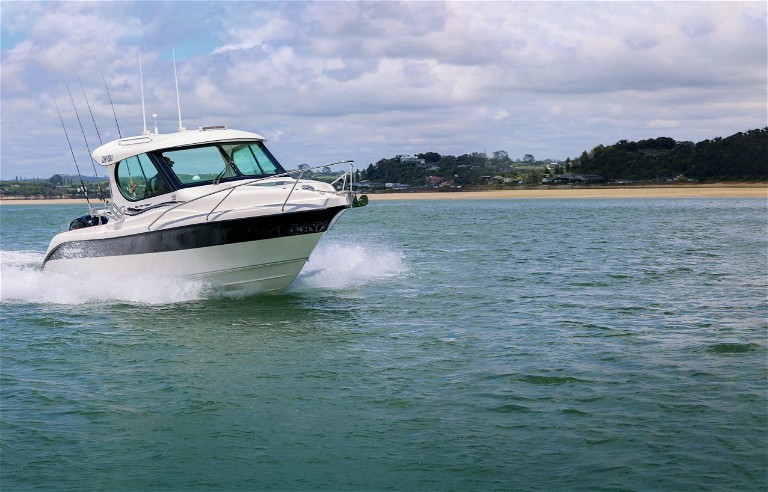
The 22-degree deadrise made short work of any chop crossing the Mangawhai Bar.
For some time now Buccaneer customers have been asking for a hardtop six-metre model, the Hamilton-based manufacturer delivering in the shape of its latest release – the Six Fifteen.
Based on the popular 605 hull, the Six Fifteen features an all-new deck, liner, screens and most importantly, a hardtop. Further buoyancy has been increased thanks to the waterline length increasing by 150mm. Raising the sheerline has helped create more height for the hard top, while increasing the transom angle from 17 to 19 degrees offers more motor trim.
Buccaneer’s Wade Gerrand brought the boat up to Mangawhai where we put it through its paces. He said customers had been requesting a six-metre hardtop for some time, so the Six Fifteen was a fulfillment of these.
“We saw a gap in the fibreglass boat market four years ago, but with the interruption of Covid and a 12-month development period, the Six Fifteen is being released for the new boating season,” Wade says.
Quite a bit of effort went into making the hardtop both practical and aesthetically pleasing.
“It had to be in keeping with the hull lines as well as offer plenty of protection from the elements.”
To this end, Wade and his father Gerry created a mockup so they could see that they had got it right.
“Producing a new model in GRP is quite a complicated process. Each part has to be moulded separately. A plug or a master is made, a mould is built and then pieced together and this is quite time-consuming compared to alloy construction. Any imperfections show in the finished component, so a lot of time goes into the process initially.”
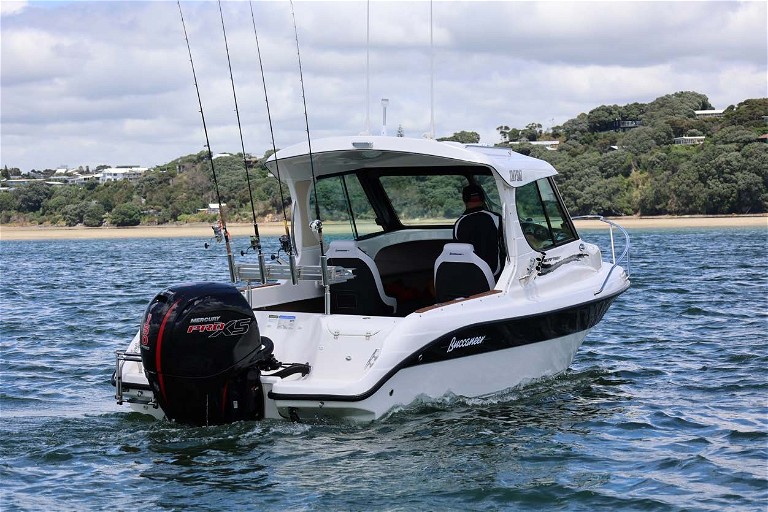
The effort that has gone into producing the Six Fifteen’s hardtop shows in the finished product.
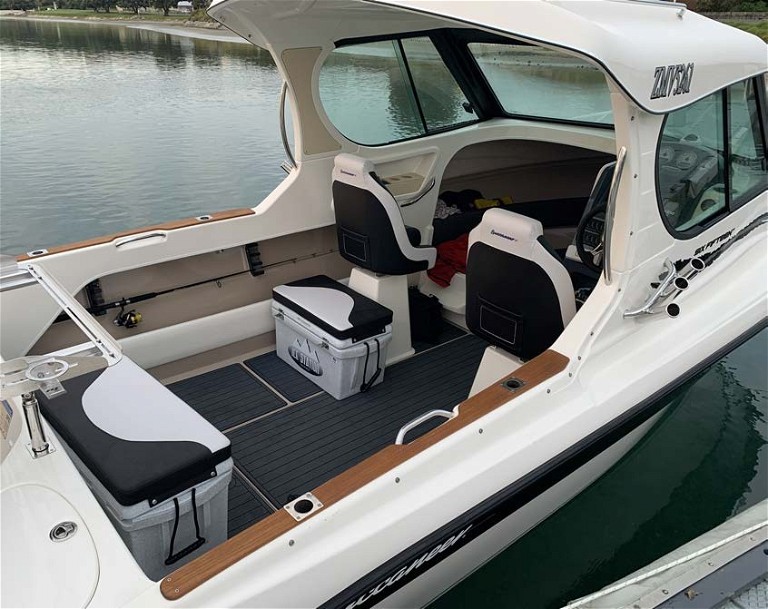
The cockpit layout featuring Sea-Dek underfoot.
Hardtop a key feature
The effort that has gone into producing the Six Fifteen’s hardtop shows in the finished product. It has nice lines that present a sleek look while providing adequate protection from the elements. Some hardtops on smaller hulls look clumsy and incongruous, almost tacked on as an afterthought. This one does not.
The front screen, with its moulded fibreglass frames, gives the top a seamless look and provides an almost unrestricted view through 180 degrees. The sliding side windows allow good airflow on those hotter days.
There is side storage incorporating cup holders on the port side, with well-positioned handrails located where they are most likely to be needed. The dash has been ‘borrowed’ from the Billfisher and Eldorado ranges and provides plenty of real estate for a 12” screen – in this case a Raymarine plotter/sounder – along with a double row of switches, Mercury analogue engine gauges, trim buttons, phone charger plugs, the Maxwell RC 6 capstan control and rode counter, plus G Com VHF and GME stereo units. A small shelf sits at the bottom, perfect for vehicle keys, cellphones, and the like.
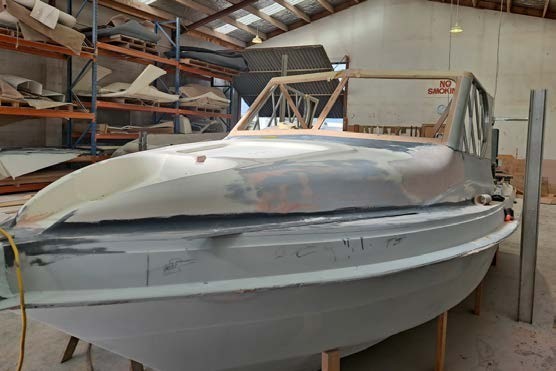
To make sure they had the lines right, a mockup of the hardtop was made before production began.

The transom is dominated by the large bait board/rigging station.
Other nice touches are the recesses built into the trailing edges of the hardtop pillars where the road cover domes fit, designed to make it more waterproof. Similarly, the space on the transom where the trim tabs attach is also recessed.
Set up for fishing
Geared towards the fishing market, the Six Fifteen features plenty of working deck space, underfloor storage, a livebait tank with viewing window on the port side and a hatched locker on the starboard side that can be utilised as a hand basin or with a bit of altering, a space where after-market tuna tubes could be mounted. The livewell aerator pump also serves the washdown pickup and there is a high-speed pickup to keep the livebaits in pristine condition when underway. A new model stainless steel Manta baitboard dominates the transom which also houses batteries and switches behind hatches. A folding ladder is mounted on the port swimstep, above the livebait tank. Underwater bait lights are fitted on the stern as an option, with a cockpit floodlight and forward-facing light bar attached to the hardtop.

The dash has been ‘borrowed’ from the Eldorado and Billfisher models.
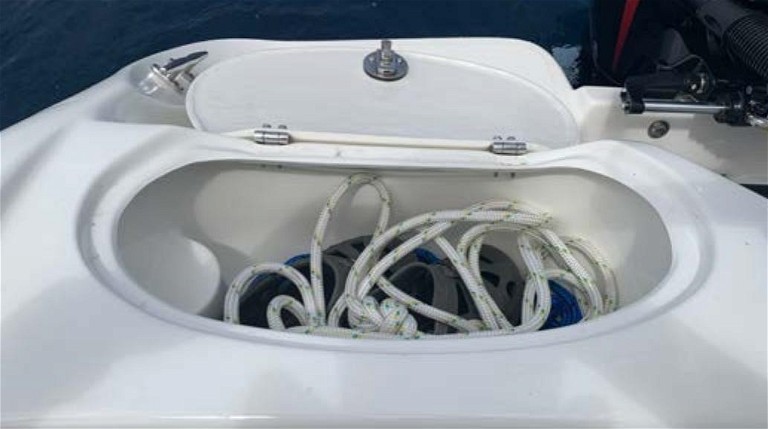
The transom locker can double as a sink and with a bit of modification can house two tuna tubes.
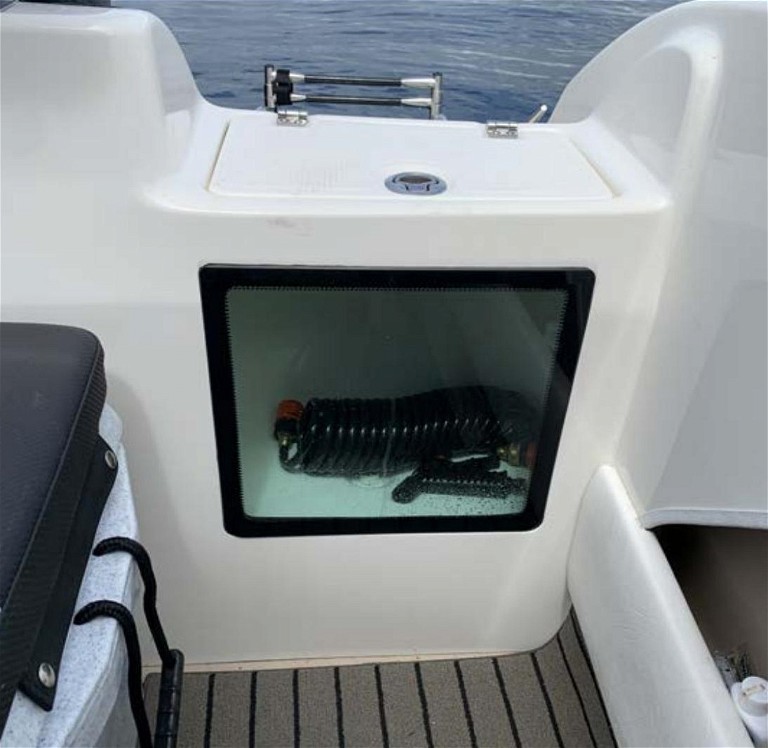
The livebait tank aerator and the washdown hose run off the same pump.
The test boat carried two Ice Station ice bins – a 40-litre one that serves as a seat with a fitted squab, and another 80-litre model, also squabbed, that sits centrally against the transom. The most likely use of the bins would be the big one for the fish, and the smaller one for the bait, food, and drinks.
The seats are mounted on fibreglass pedestals and are reversible – great for days spent trolling when you need to keep an eye on the lures or rods for a strike, be it a billfish or a trout. There is minimal intrusion into the deck fishing space, even with the second ice bin in place. Both seats are bolstered, providing support for the crew whether standing or sitting.
SeaDek flooring features throughout the boat. This is one product I would never be without. It provides solid grip even when wet, is durable, and is comfortable to stand on for long periods.
Rod holders on board include two on each port and starboard gunwale covering boards, and a further three (Buccaneer-style) on either side of the hardtop. These are angled, making them ideal when seeking a bit of extra spread when trolling multiple lines for trout.
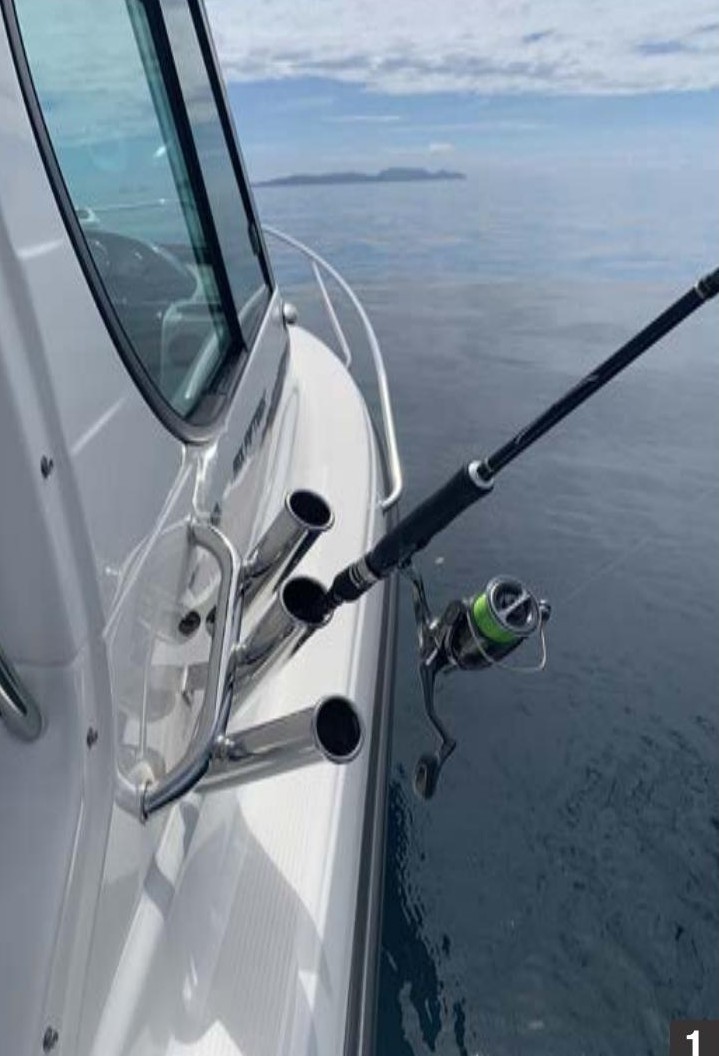
1) Buccaneer’s bespoke rod holders.
Long shelves run on either side of the cockpit and these contain holders for rods, gaffs, boat hooks and the like. They are long enough to contain 8’ or longer softbaiting or topwater rods. The bottoms are deep enough to swallow up kingfish/tuna fixed head gaffs. The sides are moulded in fibreglass as opposed to vinyl-covered wood, making them more durable.
The height of the gunwales is comfortable – low enough to not impede the rod work, but high enough to provide security when working on a decent capture or leaning over the side to release a fish, deploy a tag or remove hooks.

2) Pedestal seat bases have minimal intrusion into the cockpit space.
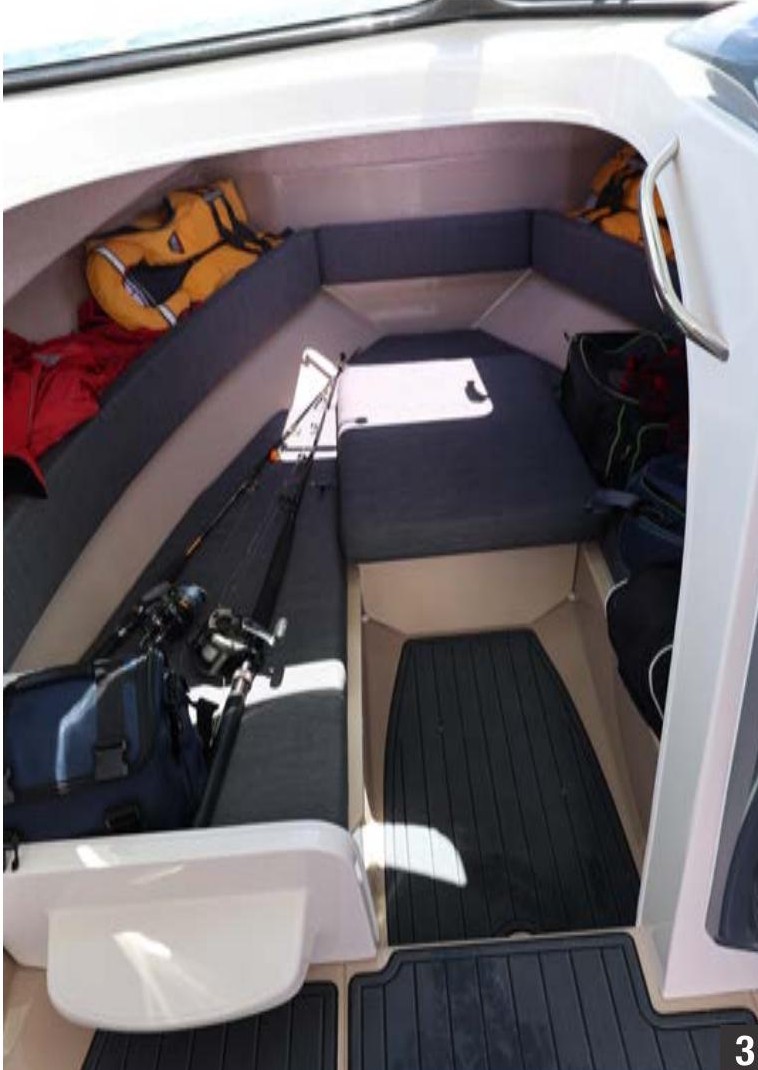
3) There is plenty of room to overnight on the full-length bunks.
Overnighting an option
One of the aspects I appreciate is the roof height in the cuddy cabin. There is a deep step-down footwell that makes accessing the two full-length bunks quite easy. There is room for a marine toilet and if you want extra sleeping space, there is an infill that covers the foot well. Shelving port and starboard is wide enough to hold lifejackets, flare packs, first aid boxes and the like.
When not overnighting, the well is a good place to lay dive bottles in ( just make sure the valves point to the bow, you don’t want them punching through the fibreglass in a rough sea if stored the other way around). A closed-cell foam double bottle holder would fit in the well nicely. The well is drained, so even dive bags containing wet gear could be placed there out of the way on those days when both diving and fishing are on the schedule. A hatch in the cabin roof lets in some natural light as well as giving access to the capstan and anchor should the need arise.

The Enduro multi-roller trailer is braked using an override system.
At the business end sits a 150HP Mercury Pro XS outboard. Featuring a heavy-duty gearbox, the Pro XS is more than enough to drive a boat of this size. The four-cylinder 3.0 litre engine produced a good hole shot, runs on 91 octane fuel, and claims to be around 20lb lighter than its nearest rival. Fuel economy is good, with a standard 165- litre tank (a 205-litre long-range capacity tank is available) providing plenty of juice for a full day’s gamefish trolling plus a safety margin to get back home on.
The rig is trailed on an Enduro trailer. While I didn’t tow the test rig, I have had experience with this make before – we had one under a previous NZ Fishing News Project Boat, a Billfisher 735 – and it towed (and stopped!) well.
Seakeeping ability
The sea state for the test run was as flat as a board with the winds not even reaching the five knot variables forecast. Crossing the Mangawhai bar near low tide was hardly a test, with a long interval half-metre swell working against an outgoing current creating a bit of a joggle the hull ate up.
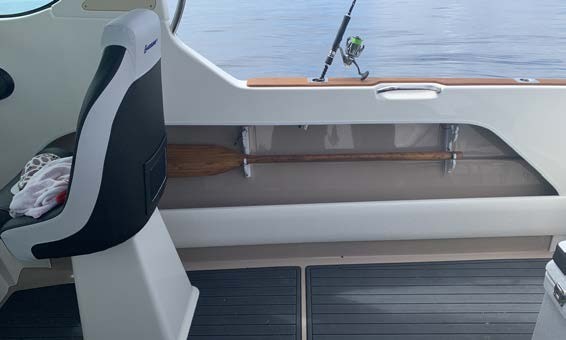
Trim tab bases are recessed into the transom.

Full-length cockpit side shelves are fitted with holders for rods, gaffs, paddles and the like.

The Six Fifteen showed all the traits I had observed in the bigger Billfisher. The 22-degree deadrise made short work of any chop, but the counter to that is the hull is less stable at rest. Trimming the boat at speed is affected by any crew changing position, and in the afternoon when the wind got up it showed the typical hardtop/deep vee tendency of heeling into the breeze – nothing that couldn’t be trimmed out using the tabs, however.
Overall impressions
A great deal of thought has gone into this new model from Buccaneer and for me it ticks a lot of boxes. There is plenty of unimpeded cockpit working space – four softbaiters for instance could comfortably operate from it with a little co-operation – as well as room for the ice bins. Storage space is good, especially wet storage.
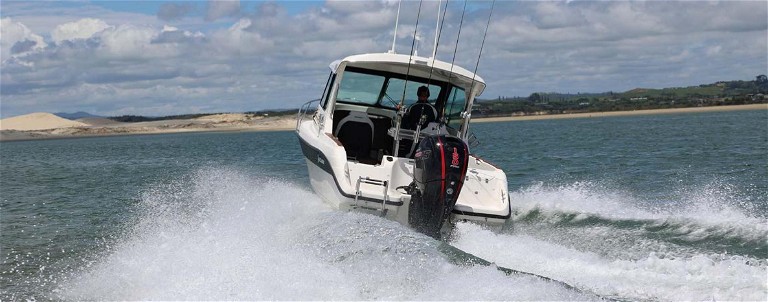
There are a number of options including the addition of a fridge which would be an advantage when overnighting, not to mention the bigger long-range fuel tank. Wade mentioned they were looking at adding an extendable cockpit bimini to provide extra shade when trolling or cruising and there is potential space for a 15” sounder/plotter screen. In the previous NZ Fishing News Project Boat Billfisher, we ran a 15” Furuno unit.
If you are in the market for a sixmetre hardtop, I would be looking seriously at the Buccaneer Six Fifteen as a viable option.
